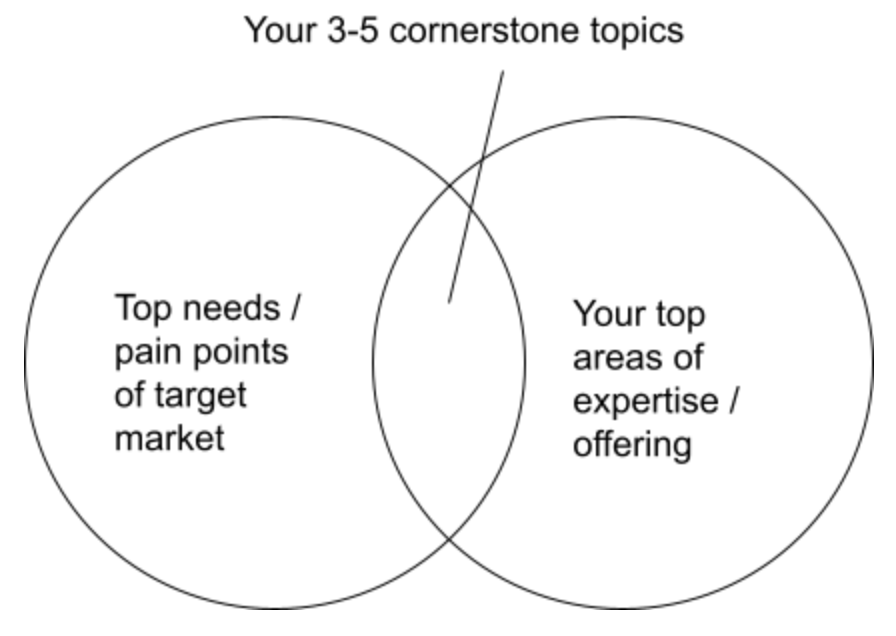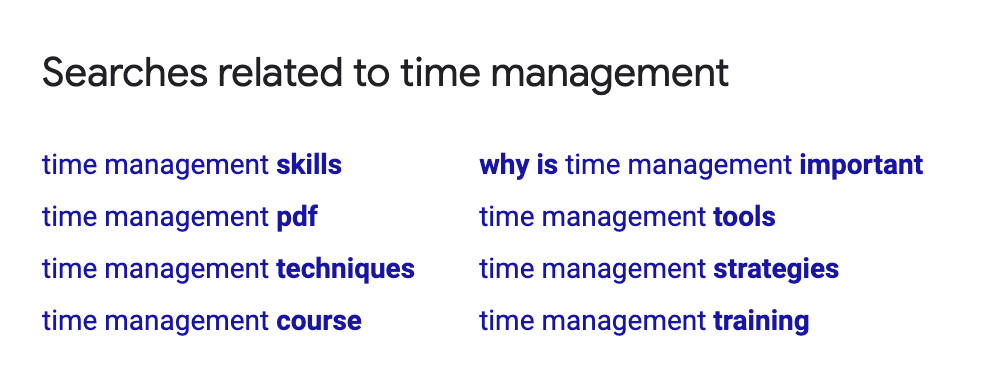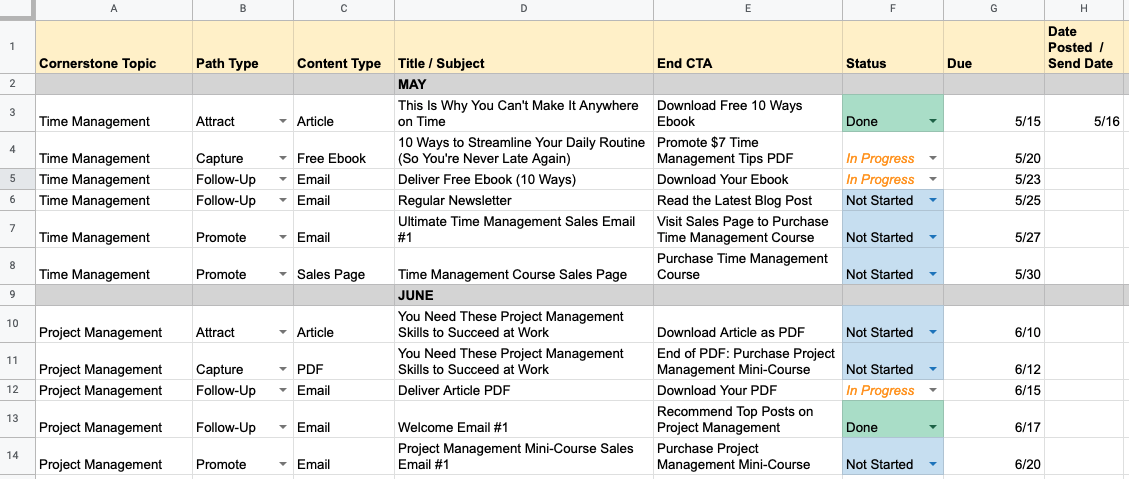Escape the Marketing Grind: Use This Simple 5-Step System to Attract Potential Customers and Make Sales

If you follow the five steps outlined in this guide, you’ll be on your way to automating your marketing. Instead of marketing being an ugly, shot-in-the-dark process, you’ll have a system for attracting and promoting to potential customers.
If you’re a small business owner looking to sell your products and services online, this will be especially relevant to you.
To escape the marketing grind, here’s what you need to do:
Step 1: Get Clear on Your 3 M’s

First, we need to talk about one of the biggest killers of marketing success for businesses — large or small.
If you don’t have your 3 M’s in place — your mission, market, and message — you’ll be running in circles. Your marketing won’t work, regardless of what you try.
- Your mission answers the question, “What am I trying to do?”
- Your market answers the question, “Who am I talking to?”
- Your message answers the question, “What am I trying to say?”
While this may seem like common sense, the answers to these questions are more complex than you might think. Many business owners try to start with their message, but they aren’t able to stay consistent or make it compelling. If you aren’t clear on your mission or who you’re marketing to, problems will start showing up in your message.
Your mission should be made up of these seven components:
- What problem you solve
- How you solve the problem (your differentiators)
- Why you solve the problem
- Who you help
- Why it matters right now
- How people can participate
- The impact of your solution
You may have an overall mission, such as, “To help young adults learn financial skills and build wealth,” but if you don’t have the details identified, you can easily run out of steam in the marketing process.
In terms of market, you need to have a clear idea of who would be interested in your products and services. You can brainstorm ideas in the “who you help” section of your mission, but when defining your target market, you’ll need to take a stab at a few more details. For example, if you’re selling nutrition supplements and fitness workshops, your target market might look like this:
- Gender: Male (60%) / Female (40%)
- Age: 35-55 years old
- Income: $75,000 - $150,000 annually
- Places they shop: Academy Sports, Nike, GMC
- Other characteristics: Enjoys recreational sports, likely to have workout equipment at home, tries to eat healthy but eats out a few times a week, spends on a budget, likes to be outdoors often, has been on diets and tried fitness bootcamps or workshops before
If you have customer data (from surveys, for instance), you can use it to create this target market profile. If you don’t, you may want to research your competitors’ audiences or make educated guesses about whom you’re targeting. Once you have customers, you can survey them and find out what the actual data points are. But you at least need a place to start, even if it’s not 100% accurate at first. This will keep you from trying to market to “everyone,” which will make your offer too weak for many potential customers.
If you’re not sure how to complete the seven components of your mission — or how to identify your target market — I wrote a book just for you called Mission, Market, Message: The Actionable Guide to Marketing for Small Business Owners. Once you work through that book, you’ll have a solid foundation for marketing to your potential customers in a compelling way that sounds like you (i.e., not gimmicky or manipulative).
But let’s say you’ve already got your mission, market, and message figured out. What’s next? You need to determine which channels will help you best reach your target market. These channels are saturated with noise from advertisers and competing agendas — so it’s important to choose wisely in order to stand out and effectively reach potential customers.
Step 2: Determine Which Channels Best Fit Your Product/Service and Target Market

Because you’re a small business owner (and let’s say you don’t have access to a major media budget), we’ll eliminate channels like TV, billboards, radio, and having small planes drag banners through the sky over beach-going crowds.
Easy access channels include social media platforms like Facebook, Instagram, Twitter, LinkedIn, Youtube, and Tiktok. You may even want to write on Medium, start a podcast (or advertise on someone else’s), pitch to magazines, or guest post on other websites. We can also include search engines here because they represent a key channel that people may use to discover your business.
While it’s not an easy task to pick channels (and please do not attempt to market on all of them), we can use a few frameworks to narrow down your options:
- Visual Content vs. Audio/Written Content. Does your product or service lend itself to visual content? For example, if you decorate wedding cakes, you’ll want to use a visually-based platform in order to showcase your designs. If you’re a professional organizer, you’ll want to post before-and-after photos. But if you’re a financial advisor, you need an audio or text-based platform so you can explain key elements of personal finance and estate planning. If you’re a writer, you need a place to post your articles or tell stories.
- Type of Product or Service. The type of product or service you offer is significant when it comes to choosing channels. If you’re a business-to-business (B2B) company, you need to focus on where other business owners or decision-makers are. They’re not hanging out on social media platforms looking for vendors — they’re probably using a search engine or getting referrals. Your competitors may all have Twitter accounts, but they may be using Twitter for a completely different purpose than courting customers — so don’t be surprised if that’s not where your leads come from.
- Direct Search vs. Referral Search. Do you have the kind of product that people would search for online, or are they more likely to get a referral from a friend? If you provide highly-customized executive consulting services, you may not benefit from investing in SEO. You may be better served by utilizing your professional network to refer you to new clients.
- Demographics. Everybody gets on Facebook, right? (Well, not anymore.) But even if they did, you can’t reach everyone on Facebook. Your target market may see your ads or content there, but that doesn’t mean they’re making decisions on that platform. It’s important to be well-versed in which platforms best reach your target market (especially when it comes to buying decisions).
On that note, let’s talk about channel demographics for a moment. Check out this social media demographic data from Sprout Social:
- 2.7 billion monthly active users
- 25-34 year olds are the largest age group (26%)
- 56% of users are male, 44% are female
- 1 billion monthly active users
- 25-34 year olds are the largest age group (33%)
- 57% of users are female, 43% are male
- 187 million daily active users
- 30-49 year olds are the largest age group (44%)
- 68% of users are male, 32% are female
- 738 million total users
- 46-55 year olds are the largest age group
- 51% of users are male, 49% are female
Youtube
- 2 billion total users
- 15-25 year-olds are the largest age group
- 72% of all male and female Internet users get on Youtube
Tiktok
- 100 million active users
- 18-24 year-olds are the largest age group
- 59% of users are female, 41% are male
It can help to see, roughly, who’s hanging out where. Demographic information can be enlightening, but the reasons why people use these platforms can be helpful as well.
Some uses are obvious: For instance, if your product is for businesses or is related to professional development, LinkedIn will likely offer more returns than Facebook, because people are seeking business and career opportunities there.
But let’s think about it a little further. According to the Sprout Social article, people spent 45+ minutes a day on Tiktok and just 3 minutes a day (or week) on Twitter. That means people are scanning Twitter for relevant updates and commentary, whereas they’re going to Tiktok to be entertained. So, should your business get on Tiktok? Maybe, if you have regular, interesting media content to surprise your followers with — but if not, why not invest elsewhere?
More food for thought: Youtube is regularly used by the 15-25 age group, but if 72% of all male and female Internet users get on Youtube, you might want to experiment with hosting some videos there. After all, Youtube is like Google now — it’s just another search engine. If your product or service lends itself to how-to’s or tutorials, you may have some success on Youtube.
Think about your product or service as well as your niche. Lots of writers hang out on Twitter because it’s a text-based platform. Lots of foodies hang out on Instagram because it’s an image-based platform. If someone was trying to discover your product or service, where would they look first? If you aren’t sure, some competitor research or experimentation with a few channels at a time can help you pinpoint the right places to market.
Step 3: Decide on Your Cornerstone Topics

You can’t be all things to all people, and neither can your business. You may want to appeal to a broad range of interests in order to attract people, but this will muddy your brand and make it unclear why people should come to you for certain products or services.
Instead, you need to decide on cornerstone topics — your areas of focus and expertise. You only need a few, probably five at maximum. You may want to be clearly known for just one. For example, did you know that Safelite AutoGlass can repair your car’s power windows and recalibrate its safety systems? You probably didn’t, because they’re the broken windshield people. When you get a crack in your windshield, that little jingle goes off in your mind — “Safelite repair, Safelite replace!” — and you know exactly who to call. Even Amazon was first known for selling books before it became recognized as the “everything” store.
What’s the signature thing you want customers to come to you for? Choosing cornerstone topics also comes in handy when you’re developing content, which you’ll be doing in the next step in this guide. Your goal is to isolate the top needs of your target market that overlap with your top areas of expertise or offering.

For example, if you’re offer time management consultations and digital courses, your cornerstone topics might be:
- Time management
- Project management
- Personal organization
- Home organization
You could have also chosen office organization, time blocking, or priority management — and you may mention those in some of your content — but they don’t need to be cornerstones. Your cornerstones are also informed by your target market. A time management consultant with the cornerstones listed above might be targeting homemakers, new home owners, self-employed professionals, or stay-at-home moms or dads. A time management consultation who chooses office management and professional scheduling may be targeting corporate professionals, business owners, or executives.
At this stage, it also helps to do a keyword search for cornerstone topics. When you type “time management” into Google, what questions or variations of the topic come up? They’re worth noting and addressing in your content.

Step 4: Create Your Customer Path
Now that you’ve chosen your cornerstone topics (or at least have a few candidates), it’s time for the most important part of your marketing strategy: Creating your customer path.
What does this mean? Just to be clear, we’re talking about inbound marketing, which means you create ways for potential customers to come to you. (An outbound approach would mean that you’re reaching out to potential clients or customers and pitching to them.)
Creating a customer path can be described as building a funnel, but the term “funnel” is used too many different ways in inbound marketing. In creating a customer path, you’re designating an entry point for potential customers — how they will find or discover you — and setting out a series of breadcrumbs that lead them to transacting with you, and even beyond, to becoming brand advocates.
Your customer path includes four types of content:
- Attract Content. This is the content (ads, articles, promotional material, word of mouth messages) that leads potential customers to your website (or to the next type of content).
- Capture Content. This is the content that you offer to potential customers in exchange for contact information they volunteer to you, such as their name and email address (ebooks, PDFs, video series, webinars, coupons, reward programs, bonuses).
- Follow-Up Content. This content should be served to your new contacts in order to follow-up and connect with them, like a welcome email series or a newsletter. (This also includes emails that deliver requested content, like ebooks, checklists, or videos).
- Promote Content. This type of content is used to promote your products and services to your potential customers.
An addendum to this list would be a fifth type of content — Ambassador Content — which can be used to encourage current customers to purchase more from you or engage further with your brand (like joining a movement or a club or becoming an affiliate).
All of your content should fall under one of these four categories so that every piece serves a particular purpose. You shouldn’t be creating random pieces of content that don’t direct your potential customers to their next step; that way lies madness, both for you and for them. While you may have a plan for not including a call-to-action on everything, you need to know why you’re creating certain types of content and how you want people to respond.
Your content should focus on your cornerstone topics. You need to answer burning questions and take a unique approach to these topics, giving people information they can use to solve key problems. The main solution, of course, is your product or service. When you promote your product or service, you also want to infuse elements of your mission, values, and what makes your business different — and why that difference can lead to certain results for your customers.
Now that you know what type of content to create (and on which topics), you need a way to systemize your content production. A system simply defines what, when, and where something will take place. Even though your system is manual, not automated, it will help you produce content on a regular basis, because you know what you’re trying to do. To start, your marketing content system can be just a spreadsheet that you use to keep track of what you’re creating, why, and when it should be completed (and shared!).
Step 5: Develop and Follow Your Production Schedule
So how do you create a content production schedule? I suggest starting with a spreadsheet that includes these items along the top:
- Cornerstone Topic
- Path Type
- Content Type
- End CTA
- Title / Subject
- Status
- Due
- Date Posted / Send Date
Here’s an example of what your spreadsheet will start to look like when you fill it in:

For fixed items like your cornerstone topics, path type (one of the four types of content we discussed above), and status, you can create miniature drop-downs so you’re simply selecting from options instead of retyping or copy/pasting all the time. If you’re a go-getter, you can also just insert a checkbox in the Status column (instead of a dropdown with options like Not Started, In Progress, Stopped, Done).
Another way to make your content production time bound is to include a month bar, shown in the example above, which helps create a “box” around what content you should be creating each month. You can also plan out your content a couple months in advance so you’re not trying to create topics when it’s time to create content.
You can use this spreadsheet as an active to-do list or simply a place to plan out and track the status of your content. Overall, it’s a system that should function smoothly for you if you get into the habit of using it. If you need reminders, it may help to map things out in your spreadsheet, then add each content piece into your project management system of choice (I use Wrike) with its particular deadline.
As you begin planning your content creation, I recommend making one complete customer path first. Start with an article on one of your cornerstone topics (Attract) that directs readers to a content upgrade PDF (Capture) which is followed by a PDF delivery email and a couple welcome emails (Follow-Up) which is followed by a short series promoting one of your products or services (Promote). Then you can start focusing on more Attract content that leads potential customers down the same path.
Keep in mind that as you build these customer paths, you can use email automation to deliver Capture content (like PDFs, etc.), Follow-Up content, and Promote content. That means the only part that you would need to do manually is to create and post Attract content (like articles and ads).
Also, just so we’re clear, you don’t have to send new contacts your Promote content right away. If you feel like they need to be on your email list for a while — receiving newsletters or some surprise digital bonuses from you over a few months — then you can wait to use it. But overall, if you stay intentional with your content creation, you’ll acquire better leads and have a better chance at making sales (when you’re ready to promote).
There you have it! Now you have a clear, productive process for reaching your potential customers and selling your products and services to them.
